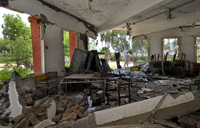Thursday, April 18, 2024
News and Views from the Global South
PAKISTAN: School Bombings Force Girls to Drop Out
Ashfaq Yusufzai
- “I am disappointed about quitting school, but my parents want me to stay at home,” says Sumaira Begum, a student of class 8 at the Government High School Mardan in Pakistan’s North West Frontier Province (NWFP). “On Mar. 20, my school was bombed after which nearly 100 girls including I stopped attending.”
A month later, a pre-dawn blast destroyed a part of the school building and scared parents forced their daughters to leave school.
So far all school bombings in the NWFP and adjoining Federally Administered Tribal Areas (FATA) have been after midnight. There have been no casualties.
A reported 118 girls’ schools have been damaged in bomb attacks over the last one year.
After banning girls’ education in the Mohmand tribal agency, the Taliban allowed girls to go to school this month, but said that both the teachers and students have to wear veils.
“This is just what the Taliban are doing in neighbouring Afghanistan. Girl students are targeted there,” says education officer, Musarratullah Khan. He estimates the total cost of repairs will be roughly 230 million rupees (nearly 6 million dollars).
Khan fears the spate of bombings and other Taliban activities will cripple female education, which is already very low in this male-dominated society.
The last school bombing was reported on May 27 from Darra Adamkhel, NWFP. The red-brick Government Girls High School, which was extensively damaged, has been shut ever since.
Militants had blown up the building of the Government Girls’ Middle School in the Kohi Wal locality of Darra Adamkhel on Mar. 19. More than a dozen girls’ schools have been damaged. Not one has reopened in the past two months.
A mere 1,939 of the 4,575 primary students in FATA are girls. Likewise in NWFP, only 134,270 of the total 366,064 primary students are female. The bias persists even among teachers. While 4,348 are female teachers, 6,788 are male.
Of the 694 high schools, in NWFP some 172 are for girls. Female enrolment is only 32,993 against 146,991 boys. The number of female teachers is 1,541 against 6,892 male teachers. Meanwhile, FATA has only 11 girls’ colleges against 22 for boys. And the number of female lecturers is 133 against 346 male lecturers.
On Mar. 20, the school in Ismaelia village, Swabi district of NWFP – 118 km west of the provincial capital, Peshawar – was destroyed partially when a bomb went off. It caused minor injuries to a watchman.
Education officer Khan says that the NWFP and FATA need 22,000 new schools to accommodate 2.8 million out-of-school children for which 55 billion dollars has been earmarked. “But the spate of bombings of girls’ schools would add to the tally of dropouts,” he added.
Police official Abdullah Jan said that women schoolteachers and girl students often received threatening letters to wear the traditional veil.
On Apr. 26, a bomb explosion damaged a girls’ school in the Noor Ali Kalay area in Kohat district, NWFP. The blast was the sixth in a row against girls’ schools during the past two months in Kohat. Extremists had earlier sent letters to several middle and high schools’ managements, ordering them to expel girls who had finished class 4. They threatened to destroy the school building or kill the principal.
Dil Afroza, an education officer in Darra Adamkhel, said the people were terrified and several students preferred to study at home instead of going to school.
“If the government does not take any action against those involved in terrorists attacks, all middle and secondary level girls’ schools in the area will be forced to close down,” Raes Khan, father of two students at the same school, told IPS.
His daughter Nabeela was emphatic that she did not want education at the cost of her life. “If I die in a blast in school, my parents will be in shock. I have decided to study under a private tutor,” she confides.
“During the past few months, the authorities have arrested 15 people in connection with the blasts at two girls’ schools, but the actual perpetrators still remain unidentified,” Dil Afroza says.
On May 5, a bomb damaged the main gate of a school in a Gujarat village in Mardan, NWFP. The mayor of Gujarat’s union council, Nigar Khan told IPS the school administration had received a threatening letter a month ago warning that if the students and staff did not observe the veil, the school building would be blown up within 15 days.
“Frightened students have started wearing the burqa. It is a new thing for them. They are not used to it. The principal has issued a verbal order [on the burqa] in this regard,” says Jamila Bibi, a class 7 student in a school in Charsadda district, close to Peshawar.
Even girls’ schools in upscale Peshawar have received anonymous threats of suicide bombing. Several schools closed ahead of the summer vacation after their administrations received threatening letters.

 Print
Print




